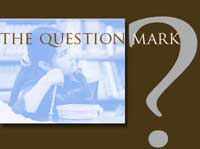Difference of Opinion
Some questions matter more to some than others. Significance is defined to some extent by personal issues, tastes and interests. Several people looking at the image below might pose very different questions.

Some might pose questions about media, media coverage and media literacy. Others might be intrigued by Michael himself and the drama surrounding his passing. Still others might wonder about the changes he made to his face over his life time. One group might find very little of importance or interest in this photograph.
Awakening a Sense of Import
In some cases, young students may not recognize the import of an image, a poem or a set of numbers. Good teachers will work on developing what amounts to a sensibility - "the ability to appreciate and respond to complex emotional or aesthetic influences; sensitivity." (Source: New Oxford American Dictionary) In some cases, the questions of import may be latent or implicit rather than explicit. Skillful teachers help their students to dig past the surface to find the deeper issues, problems and meanings that might otherwise be missed.
The painting mentioned in the sample lesson above, "Four Boys on the Beach" by Winslow Homer, is a case in point. For copyright reasons, we will not display the image here, but if the reader clicks on the link below, the image will open in a new window and the discussion that follows can be set alongside the image in a separate window.
http://www.nga.gov/content/ngaweb/Collection/art-object-page.56946.html
The boys' body language may be a matter of import but young students may not naturally fix their attention on how the boys are sitting. At the same time, the artist has kept the details of their positions somewhat vague. Once the group tries to figure out if all four boys are sitting with their backs turned to us looking at something happening in the foggy background, the meaning of the painting seems to change. The importance of the background increases and the mystery of the image increases.
In an effort to find a larger version of this painting on Google Images, the group might chance upon "Ship-Building, Gloucester Harbor," which is a composite of the water color above and three other of his works. This one is more explicit and shows the boys in reverse with the National Gallery telling us, "Children often gathered in the shipyard after school, to collect chips for kindling, build chip houses, observe the workmen, and to carve and rig miniature vessels." Both works carry dates of 1873. They differ dramatically in the amount of clarity vs. mystery in each.
By definition, questions of import are intended to explore meanings. When looking at images or collections of data, we train our students to ask "What's the story here? What's going on? What's the theme? What's the main or most important idea? Is there a message?"
It is our hope and our goal to awaken this questioning spirit in contrast to a more passive, couch potato stance. We expect that students will learn to scratch the surface, dig for meaning, wonder about significance and push past the obvious to figure things out for themselves.
Making School and Learning Important
If only more students felt school was important - full of meaning and significance. Many of them do feel that way, of course, especially those with teachers who challenge them to wrestle with questions and issues that matter. But there are far too many who suffer through school wondering what it has to do with their lives and futures. When learning is organized around questions of import, they see the connection between the inquiry at hand and their lives. School becomes important - full of meaning - full of import.
Several decades ago, Paul Simon stated the issue rather drastically when he sang . . .
- When I think back
On all the crap I learned in high school
It's a wonder
I can think at all
And though my lack of education
Hasn't hurt me none
I can read the writing on the wall
Infusing learning with questions of import is a potent way to address this issue of significance.




